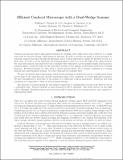Efficient Confocal Microscopy with a Dual-Wedge Scanner
Author(s)
Warger, William C., II; Guerrera, Stephen; Eastman, Zachary; DiMarzio, Charles A.
DownloadWarger-2009-Efficient confocal microscopy with a dual-wedge scanner.pdf (2.964Mb)
PUBLISHER_POLICY
Publisher Policy
Article is made available in accordance with the publisher's policy and may be subject to US copyright law. Please refer to the publisher's site for terms of use.
Terms of use
Metadata
Show full item recordAbstract
Confocal microscopes achieve high spatial resolution by focusing both a light source and a detector to a single point with an objective having a high numerical aperture. In order to produce an image, it is then necessary to scan this common focal spot through the specimen, and it is often important to image the full field of view in a short time. In order to avoid vignetting, the scanning must be done in or near the pupil of the optical system. For some fast scanners, this requires the use of multiple relay telescopes to create multiple pupils. Galvanometric scanners impose a practical limit on the scan speed because of the angular accelerations involved in reversing direction. Rotating polygons are often used to achieve greater speed. For a scanner consisting of a rotating polygon and a galvanometric scanner, two relay telescopes are normally used. We have developed a dual-wedge scanner which has the potential to perform the scan in a configuration which is very short in the axial direction, thereby eliminating much of the complexity of current high-speed scanners. We have demonstrated a prototype of the scanner in a reflectance confocal microscope. Transverse and axial resolution are comparable to those of other scanning systems. The selection of rotation speeds for the wedges is important to ensuring full coverage of the field of view in a reasonable time. Various tradeoffs on these parameters will be discussed. The beam behavior in the pupil will be discussed. Resolution limits and aberrations will be shown from ray-tracing analysis, and compared to experimental results.
Date issued
2009-03Department
Massachusetts Institute of Technology. Department of Electrical Engineering and Computer ScienceJournal
Proceedings of SPIE--the International Society for Optical Engineering
Publisher
Society of Photo-optical Instrumentation Engineers
Citation
Warger II, William C. et al. “Efficient confocal microscopy with a dual-wedge scanner.” Three-Dimensional and Multidimensional Microscopy: Image Acquisition and Processing XVI. Ed. Jose-Angel Conchello, Carol J. Cogswell, & Tony Wilson. San Jose, CA, USA: SPIE, 2009. 71840M-11. © 2009 SPIE
Version: Final published version
Other identifiers
SPIE CID: 71840M-11
ISSN
0277-786X